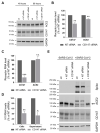SARS-CoV-2 Entry: At the Crossroads of CD147 and ACE2
- PMID: 34201214
- PMCID: PMC8226513
- DOI: 10.3390/cells10061434
SARS-CoV-2 Entry: At the Crossroads of CD147 and ACE2
Abstract
In late 2019, the betacoronavirus SARS-CoV-2 was identified as the viral agent responsible for the coronavirus disease 2019 (COVID-19) pandemic. Coronaviruses Spike proteins are responsible for their ability to interact with host membrane receptors and different proteins have been identified as SARS-CoV-2 interactors, among which Angiotensin-converting enzyme 2 (ACE2), and Basigin2/EMMPRIN/CD147 (CD147). CD147 plays an important role in human immunodeficiency virus type 1, hepatitis C virus, hepatitis B virus, Kaposi's sarcoma-associated herpesvirus, and severe acute respiratory syndrome coronavirus infections. In particular, SARS-CoV recognizes the CD147 receptor expressed on the surface of host cells by its nucleocapsid protein binding to cyclophilin A (CyPA), a ligand for CD147. However, the involvement of CD147 in SARS-CoV-2 infection is still debated. Interference with both the function (blocking antibody) and the expression (knock down) of CD147 showed that this receptor partakes in SARS-CoV-2 infection and provided additional clues on the underlying mechanism: CD147 binding to CyPA does not play a role; CD147 regulates ACE2 levels and both receptors are affected by virus infection. Altogether, these findings suggest that CD147 is involved in SARS-CoV-2 tropism and represents a possible therapeutic target to challenge COVID-19.
Keywords: ACE2; CD147; COVID-19; EMMPRIN; SARS-CoV-2; basigin; entry; infection.
Conflict of interest statement
The authors declare no conflict of interest.
Figures



Similar articles
-
CD147-spike protein is a novel route for SARS-CoV-2 infection to host cells.Signal Transduct Target Ther. 2020 Dec 4;5(1):283. doi: 10.1038/s41392-020-00426-x. Signal Transduct Target Ther. 2020. PMID: 33277466 Free PMC article.
-
Human Basigin (CD147) Does Not Directly Interact with SARS-CoV-2 Spike Glycoprotein.mSphere. 2021 Aug 25;6(4):e0064721. doi: 10.1128/mSphere.00647-21. Epub 2021 Aug 11. mSphere. 2021. PMID: 34378982 Free PMC article.
-
Tumor markers as an entry for SARS-CoV-2 infection?FEBS J. 2020 Sep;287(17):3677-3680. doi: 10.1111/febs.15499. Epub 2020 Aug 28. FEBS J. 2020. PMID: 32738184 Free PMC article. Review.
-
CD147 antibody specifically and effectively inhibits infection and cytokine storm of SARS-CoV-2 and its variants delta, alpha, beta, and gamma.Signal Transduct Target Ther. 2021 Sep 25;6(1):347. doi: 10.1038/s41392-021-00760-8. Signal Transduct Target Ther. 2021. PMID: 34564690 Free PMC article.
-
Epithelial and Endothelial Expressions of ACE2: SARS-CoV-2 Entry Routes.J Pharm Pharm Sci. 2021;24:84-93. doi: 10.18433/jpps31455. J Pharm Pharm Sci. 2021. PMID: 33626315 Review.
Cited by
-
Human motor neurons derived from induced pluripotent stem cells are susceptible to SARS-CoV-2 infection.Front Cell Neurosci. 2023 Dec 5;17:1285836. doi: 10.3389/fncel.2023.1285836. eCollection 2023. Front Cell Neurosci. 2023. PMID: 38116398 Free PMC article.
-
Going viral in the islet: mediators of SARS-CoV-2 entry beyond ACE2.J Mol Endocrinol. 2022 Jun 17;69(2):R63-R79. doi: 10.1530/JME-21-0282. J Mol Endocrinol. 2022. PMID: 35521990 Free PMC article. Review.
-
Development of a Novel Human CD147 Knock-in NSG Mouse Model to Test SARS-CoV-2 Viral Infection.Res Sq [Preprint]. 2022 Apr 20:rs.3.rs-1431484. doi: 10.21203/rs.3.rs-1431484/v1. Res Sq. 2022. Update in: Cell Biosci. 2022 Jun 11;12(1):88. doi: 10.1186/s13578-022-00822-6. PMID: 35475172 Free PMC article. Updated. Preprint.
-
A Comparison of Conserved Features in the Human Coronavirus Family Shows That Studies of Viruses Less Pathogenic than SARS-CoV-2, Such as HCoV-OC43, Are Good Model Systems for Elucidating Basic Mechanisms of Infection and Replication in Standard Laboratories.Viruses. 2025 Feb 13;17(2):256. doi: 10.3390/v17020256. Viruses. 2025. PMID: 40007010 Free PMC article. Review.
-
AC-73 and Syrosingopine Inhibit SARS-CoV-2 Entry into Megakaryocytes by Targeting CD147 and MCT4.Viruses. 2024 Jan 4;16(1):82. doi: 10.3390/v16010082. Viruses. 2024. PMID: 38257782 Free PMC article.
References
-
- Gorbalenya A.E., Baker S.C., Baric R.S., de Groot R.J., Drosten C., Gulyaeva A.A., Haagmans B.L., Lauber C., Leontovich A.M., Neuman B.W., et al. The Species Severe Acute Respiratory Syndrome-Related Coronavirus: Classifying 2019-NCoV and Naming It SARS-CoV-2. Nat. Microbiol. 2020;5:536–544. doi: 10.1038/s41564-020-0695-z. - DOI - PMC - PubMed
MeSH terms
Substances
LinkOut - more resources
Full Text Sources
Miscellaneous

